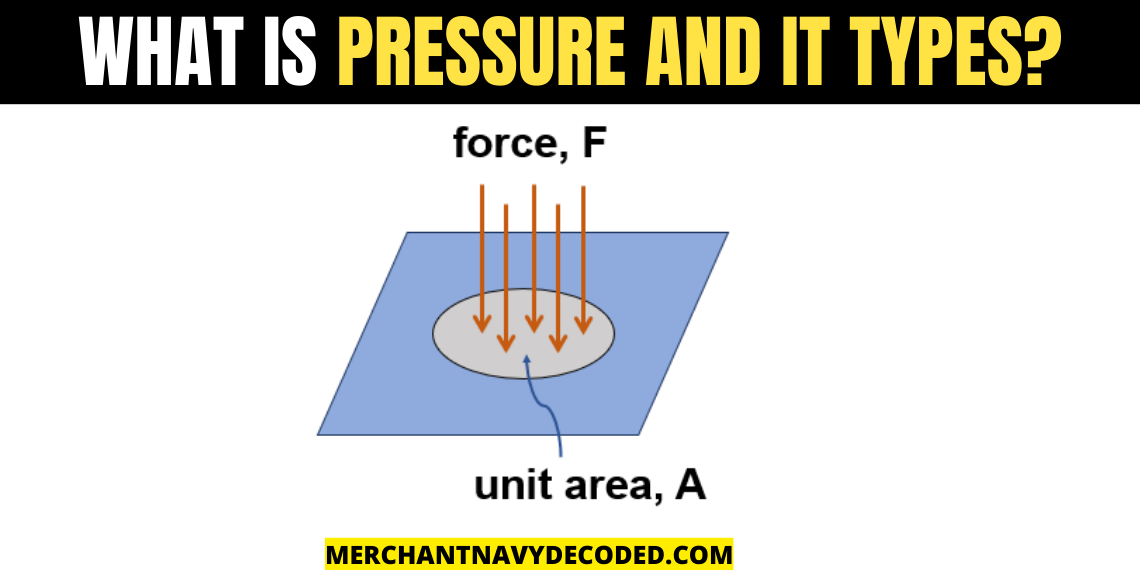What is Pressure and its types? How is atmospheric pressure measured on ship?
Definition: Pressure is the amount of force exerted per unit area.


For example, if you take two knives one sharp which has less surface area, and a blunt one which has more surface area. If you try to cut something with both knives with the same force you will see that both will perform differently, the sharp one will penetrate more through the object, and the dull one will penetrate less. This is because, with a sharper knife with the same force applied, the pressure tends to become much more and thus cutting the cake becomes easier.
Atmospheric pressure
Definition: Pressure exerted by the atmosphere is known as atmospheric pressure.
Earth is surrounded by the atmosphere, there are air molecules above you anytime which have weight. When you are at sea level there are more air molecules above you hence more atmospheric pressure is exerted upon you and if you stand on a mountain there will be less atmospheric pressure exerted upon you.

At sea level, the atmospheric pressure is higher than pressure at mountains. As altitude increases, the pressure decreases due to the decreasing density of the air with increasing altitude. At higher altitudes, there is less air above an object to exert a pressure on it, and so the pressure exerted by atmosphere decreases. At the summit of Mount Everest, which is the highest point on Earth, the atmospheric pressure is around only about one-fourth of the pressure at sea level.


How is atmospheric pressure measured?

Barometer
Atmospheric pressure can be measured by a device called a Barometer. We use mercury in the barometer because the density of mercury is a maximum of

Why don’t we use water in the Barometer to measure Atmospheric pressure?

Water can be used in a barometer, but the height of the column of water required to produce a measurable pressure difference is much greater than that required with mercury. This is because water is much less dense than mercury, and as a result, the pressure exerted by a column of water is much less than that exerted by an equivalent column of mercury.
From the above image, we can see that when atmosphere exerts pressure on the mercury it rises up in the glass tube, it rises 76cm or 760mm in the tube. If we will use water in place of mercury it will rise up to 10.3m because the density of water is 1000 kg/m^3 and we need long glass tubes.
What does a Barometer look like?

Reading a barometer is relatively straightforward, and it involves two main steps:
Step 1: Set the reference value
Before you can read a barometer, you need to set the reference value. This value represents the baseline of pressure exerted by the atmosphere in your location. To set the reference value, turn the knob on the back of the barometer until the hand lines up with the current reading of your local weather station or use an online source to find the current atm pressure for your location.
Step 2: Read the current value
To read the current value of the barometer, simply look at where the hand is pointing on the dial. If the hand is pointing to a value higher than the reference value you set in step 1, it means the pressure exerted by atmosphere is rising, which typically indicates clear and calm weather. If the hand is pointing to a value lower than the reference value, it means the pressure exerted by atmosphere is falling, which typically indicates stormy or unsettled weather.
Note:
If you want to learn more about this topic, we suggest checking out our Combo package with the given link https://merchantnavydecoded.com/courses/c/ . It’s a great way to dive deeper into the subject through video explanations. This package covers all the important details and presents them in an easy-to-understand format. Watching the videos will help you grasp the topic better and make learning more enjoyable. So, we highly recommend giving our Combo package a try to enhance your knowledge on the subject.
Disclaimer :- The opinions expressed in this article belong solely to the author and may not necessarily reflect those of Merchant Navy Decoded. We cannot guarantee the accuracy of the information provided and disclaim any responsibility for it. Data and visuals used are sourced from publicly available information and may not be authenticated by any regulatory body. Reviews and comments appearing on our blogs represent the opinions of individuals and do not necessarily reflect the views of Merchant Navy Decoded. We are not responsible for any loss or damage resulting from reliance on these reviews or comments.
Reproduction, copying, sharing, or use of the article or images in any form is strictly prohibited without prior permission from both the author and Merchant Navy Decoded.


